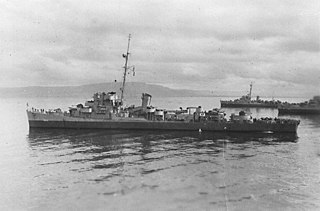
USS Howorth (DD-592) was a Fletcher-class destroyer built for the United States Navy during World War II.

USS Callaghan (DD-792), a Fletcher-class destroyer, was a ship of the United States Navy named for Rear Admiral Daniel J. Callaghan (1890–1942), who was killed in action in the Naval Battle of Guadalcanal and posthumously awarded the Medal of Honor for heroism during the action.

USS Halligan (DD-584) was a Fletcher-class destroyer of the United States Navy, named for Rear Admiral John Halligan, Jr. (1876–1934).

USS George E. Badger (DD-196/CG-16/AVP-16/AVD-3/APD-33) was a Clemson-class destroyer in the United States Navy during World War II; she was named for Secretary of the Navy George E. Badger (1795–1866).

USS Stanly (DD-478) was a Fletcher-class destroyer in service with the United States Navy from 1942 to 1947. She was scrapped in 1972.

USS Capps (DD-550), a Fletcher-class destroyer, was a ship of the United States Navy named for Rear Admiral Washington L. Capps (1864–1935).

USS Patterson (DD-392), a Bagley-class destroyer, was the second ship of the United States Navy to be named for Daniel Todd Patterson, an officer of the US Navy who served in the Quasi-War with France, First Barbary War, and the War of 1812.

USS Haggard (DD-555) was a Fletcher-class destroyer of the United States Navy named for Captain Haggard of the Louisa, who fought in the Quasi-War.

USS Bull (DE-693/APD-78) was a Buckley-class destroyer escort, later converted to a Charles Lawrence-class high speed transport. She was the second Navy ship named after Lieutenant Richard Bull (1914–1942), a naval aviator who was posthumously awarded the Distinguished Flying Cross.

USS Sims (DE-154/APD-50) was a Buckley-class destroyer escort in service with the United States Navy from 1943 to 1946. She was scrapped in 1961.

USS Barr (DE-576/APD-39), originally a Buckley-class destroyer escort, and later a Charles Lawrence-class fast transport of the United States Navy named for Pvt. Woodrow Wilson Barr of Keyser, West Virginia.

USS Robert H. Smith (DD-735/DM-23) was the lead ship of her class of destroyer minelayers in the United States Navy.

The third USS Champion (BAM-1/AM-314/MSF-314) was an Auk-class minesweeper of the United States Navy.

USS Halloran (DE-305) was a Evarts-class destroyer escort of the United States Navy.
USS Spectacle (AM-305) was a steel-hulled Admirable class minesweeper built for the U.S. Navy during World War II. A trained crew boarded the new vessel, practiced with her minesweeping gear, and then proceeded to the Pacific Ocean to clear mines from Japanese beaches so that Allied forces could invade. While performing this dangerous task of mine clearance, a Japanese plane strafed her, and another deliberately crashed into her. When she returned to the United States, her battle damage was so severe that the U.S. Navy decided to scrap, rather than to repair, her. She was awarded two battle stars.

The second USS Fleming (DE-32), and first ship of the name to enter service, was an Evarts-class destroyer escort built for the United States Navy during World War II. While performing convoy and escort duty in the Pacific Ocean she was also able to sink one Japanese submarine and to shoot down several kamikaze planes that intended to crash onto her. For her military prowess under battle conditions, she was awarded four battle stars.

USS Sederstrom (DE-31) was a Evarts-class destroyer escort of the United States Navy during World War II. She was promptly sent to the Pacific Ocean to escort convoys and to protect other ships from Japanese planes and submarines. Her assignments took her from one battle area to another, but she was fortunate in remaining almost unscathed by the end of the war. For her efforts in battle areas, she was awarded five battle stars by war's end.

USS Rall (DE-304) was an Evarts-class destroyer escort of the United States Navy during World War II. She was sent off into the Pacific Ocean to protect convoys and other ships from Japanese submarines and fighter aircraft. She performed escort and anti-submarine operations in dangerous battle areas and returned home with three battle stars.

USS Wesson (DE-184) was a Cannon-class destroyer escort built for the United States Navy during World War II. She served in the Pacific Ocean and provided escort service against submarine and air attack for Navy vessels and convoys. She returned home at war's end with a very respectable seven battle stars to her credit.

USS Richard S. Bull (DE-402) was a John C. Butler-class destroyer escort in service with the United States Navy from 1944 to 1946. She was finally sunk as a target in 1969.


















